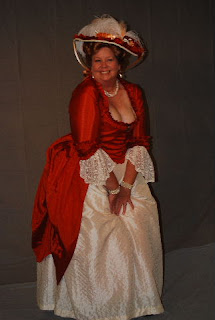When I first started costuming about seven years ago, I bought some two-toned black striped upholstery material, knowing I wanted to make a bustle gown out of it. I started on the bodice right away, using Truly Victorian's #420 (now called 460) and the pleated skirt, #221.
.jpg)
.jpg)
I cut out & sewed the bodice & bustle apron first, using TV #362, but set it aside to start making more light-weight fabric gowns.
Six years later I went back to it, and realized I didn't have enough fabric to make the skirt. So I used a solid black silk dupioni, and made the pleated ruffle around the hem. I sewed a velvet ribbon along the top where they were attached. I had plans to use this skirt for other costumes too.
I wanted to make this as my Best Black Dress similar to what the ladies would wear for fancy events or photographs. I wanted it really fancy, & over the top with trims, so I knew I would be collecting lots of trims and ribbons for it. Finding black is pretty easy. I also wanted to use it for "mourning" events, and so black glass trims worked well for that too.
When I tried on the bodice again, it was too big. Fortunately it wasn't lined so I was able to take it in. I finished the sleeves, and started the trimming. I had plans to wear it in the next two months to a mourning event, The Bennington Memorial at Fort Rosecrans, and to Costume College in Los Angeles.
I spent many hours where I handsewed all the trims on it, and enjoyed every minute. I used three layers of trim along the neckline, the bottom edges of the bodice, and the sleeves. I use antique lace in the inside of the neck edge, black beaded braid on top of it, then some lace appliques, and sewed some black glass dress decorations I'd bought at a flea market. Those were also used down the front of the bodice, which used hooks and eye closures.


Here you can see the sleeves and the bottom edge of the bodice.
I found two cloak closures made of brass and black glass, and put those on the back of the bodice pleats.

I put the bustle apron together, sewing a 2 inch black pleated grosgrain ribbon to the front edge, and then layered another black beaded trim on top of it. My friends came over and helped pin up the bustling in the back, and it came out lovely.


I was inspired by a photo on the internet of a gown with braided tassels and a rosette hanging from the side of the bustle. With the help of another friend, I made a black rosette out of wide ribbon, and attached an antique black glass button to it's center.

I used some black cording from the upholstery section of a fabric store, and hung it from the front of the apron to the side, where I put the rosette on top of it. I hung three cords down from it, and attached some tassels. I had no idea how to attach or finish the cords, so I just sewed them together and wrapped the threads around it until it seemed like it would hold.

I found an antique capote hat in an antique shop in Sacramento, and it was the right era for this gown. It's supposed to sit on the back, cupping your head. Mine is a wire frame and holds onto my head very well.
The gown was finished in plenty of time to wear it to both planned events. These were taken of me at the Sunday Tea at Costume College, in Aug '09.

















.jpg)
.jpg)








